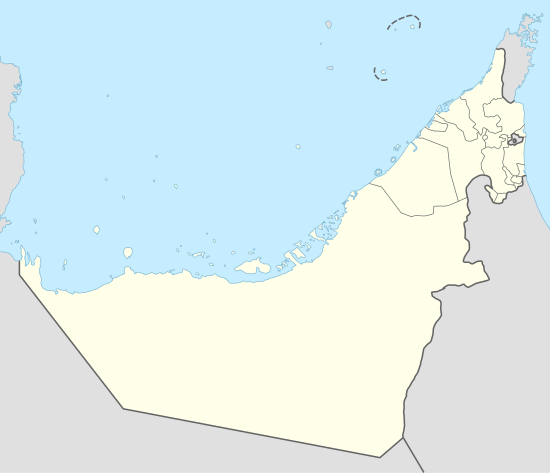Kalba
| Kalba كلباء | ||
|---|---|---|
| town | ||
| Kalba | ||
|
Mangrove swamp in Khor Kalba | ||
| ||
 Kalba Location of Kalba | ||
| Coordinates: 25°04′27″N 56°21′19″E / 25.07417°N 56.35528°E | ||
| Country | United Arab Emirates | |
| Emirate | Al-Sharjah | |
| Government | ||
| • Emir | Sultan bin Muhammad Al-Qasimi | |
| Time zone | UAE standard time (UTC+4) | |
Kalba (Arabic: كلباء Kalbāʾ) is a town in the United Arab Emirates. It is an exclave of the emirate of Sharjah lying on the Gulf of Oman coast north of Oman and south of the emirate of Fujairah. Khor Kalba (Kalba Creek), an important nature reserve and mangrove swamp, is located south of the town by the Omani border. The town was captured by the Portuguese Empire in the 16th century and was referred to as Ghallah.[1] It was attacked, sacked and put to the torch by the Sultan of Muscat's forces in March 1811 as part of the ongoing British/Omani campaigns against the maritime forces of the Al Qassimi.[2] It was a Trucial State from 1936 to 1951 before being reincorporated into Sharjah.
Khor Kalba is currently closed to the public and is being developed as an eco-tourism resort by the Sharjah Investment and Development Authority (Shurooq). A number of conservationists and ecologists have expressed concern regarding the project.[3]
History
Kalba was still being referred to as Ghallah at the time of Lorimer's 1906 survey of the Persian Gulf and Oman, when it was apparently home to ten boats trading with ports in the Persian Gulf and India.[4]
Majid bin Sultan bin Saqr Al Qasimi was granted the Shamaliyah region, including Kalba, as a fiefdom by his brother, Salim bin Sultan Al Qasimi, Ruler of Sharjah. Kalba was subsequently ruled jointly by his two sons Hamad bin Majid and Ahmad bin Majid.
Hamad's son Said Bin Hamad succeeded him in 1902 at the time when the ruler of neighbouring Fujairah, Hamad bin Abdallah Al Sharqi, managed to establish independence. Said bin Hamad lived in Ajman, leaving the administration of Kalba in the hands of a slave named Barut. By the 1920s, he took up residency in Kalba again and in 1936 was recognised by the British as a Trucial Ruler as an incentive to grant landing rights to an emergency air-strip as a backup to the Imperial Airways runway and fort at Al Mahatta in the city of Sharjah.
Shortly afterwards, in April 1937, Said bin Hamad died while his eldest son, Hamad, was still a minor. His daughter Aisha rushed from his deathbed in Khor Fakkan directly to Kalba, organised the town's defences and put the slave Barut in charge. She then sent a message requesting aid to her husband, the former Ruler of Sharjah, Sheikh Khalid bin Ahmed Al Qassimi. The subsequent debates and political jockeying over the succession involved many of the rulers of the Trucial States as well as the British Residency Agent.[1]
In June 1937, the notable residents of Kalba selected the slave Barut as Regent for the 12-year-old Hamad, but this solution was not accepted by the British and a compromise candidate, Aisha's husband Khalid bin Ahmed Al Qasimi was selected as Regent. He ruled over Dhaid and Kalba (delegating his rule in Kalba to Barut) until 1950, when he was too old and infirm to take a role in affairs. In 1951, the last male descendent in the Qassimis of Kalba, Hamad bin Said, died.[1] The rule of Kalba reverted to direct administration to Sharjah, although there are British records of an insurgency in 1952 this appears to have been settled.[5]
That notwithstanding, there were almost constant outbreaks of squabbling and disputes between Kalba and neighbouring Fujairah (itself only recognised as a Trucial State by the British in 1952) which broke out into open fighting over a land dispute after the UAE was founded in 1971 and, in 1972 the newly founded Union Defence Force was called in to take control of the fighting which, by the time the UDF moved in, had killed 22 and seriously injured a dozen more. The dispute was finally settled after mediation between Sheikh Rashid of Dubai and other Rulers and a statement announcing the settlement sent out on 17 July 1972.[6]
City access
Khor Kalba is accessible by three roads. The first merges after Wadi al-Haloo (وادي الحلو) tunnel with Maliha Road (شارع مليحة) which finally leads to the Sharjah-Kalba Road (90 km) from Sharjah International Airport.There is also the Fujairah-Kalba road (8 km).The Khor Kalba road extends until the border with Oman, and is one of the exit–entry points between the UAE and Oman.
Rulers
- Majid bin Sultan al-Qasimi (1871–1900)
- Hamad bin Majid al-Qasimi (1900–1903)
De facto independence of Kalba from Sharjah in 1903. Britain recognized Kalba on 8 December 1936.
- Said ibn Hamad al-Qasimi (1903–30 April 1937)
- Hamad ibn Said al-Qasimi (30 April 1937 – 1951)
- Saqr ibn Sultan al-Qasimi (1951–1952; Ruler of Sharjah ruler from 1951–1965)
Re-incorporated into Sharjah in 1952.
References
- 1 2 3 Bey, Frauke (1982). From Trucial States to United Arab Emirates. UK: Longman. p. 533. ISBN 0582277280.
- ↑ Qasimi, Sultan (1986). The Myth of Piracy in the Arabian Gulf. UK: Croom Helm. p. 153. ISBN 0709921063.
- ↑ Todorova, Vesela (20 May 2012). "Mangrove fears over Emirates eco-tourism project". The National. Retrieved 17 November 2014.
- ↑ Lorimer, JG (1908). Gazeteer of the Persian Gulf, Oman & Central Arabia. Government of India. p. 1440.
- ↑ Secret Cabinet Office Record CC 52, April 1952, Cabinet Office minutes of Cabinet Meeting of 29 April 1952, Page 72. The National Archive, UK.
- ↑ Wilson, Graeme (1999). Father of Dubai. UAE: Media Prima. p. 178. ISBN 9789948856450.
Khor Kalba & Kalba Corniche | Following The Bikers’ Trail


